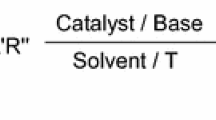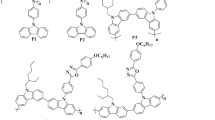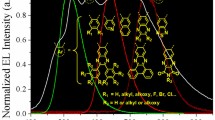Abstract
This article summarized the recent advance on the structural design and synthetic strategies of intramolecular charge-transfer compounds as well as their potential applications in two-photon absorption chromophores, organic photovoltaics and organic light-emitting diodes.
摘要
本文综述了分子内电荷转移化合物的结构设计和合成策略, 及其在双光子吸收材料、有机光伏器件和有机发光二极管等领域的应用进展.
Similar content being viewed by others
References
Li C, Li M, Li Y, et al. Newanisopleural spindle-like nonlinear optic (NLO) chromophores with a D-D′-π-A′-A or D-A′-π-D′-A structure: interesting optical behavior and DFT calculation results. J Mater Chem C, 2016, 4: 8392–8398
Bredas JL, Durrant JR. Organic photovoltaics. AccChem Res, 2009, 42: 1689–1690
Wang C, Okabe T, Long G, et al. A novel D–π–A small molecule with N-heteroacene as acceptor moiety for photovoltaic application. Dyes Pigments, 2015, 122: 231–237
Lin Y, Li Y, Zhan X. Small molecule semiconductors for high-efficiency organic photovoltaics. Chem Soc Rev, 2012, 41: 4245–4272
Liu F, Zhou Z, Zhang C, et al. A thieno[3,4-b]thiophene-based non-fullerene electron acceptor for high-performance bulk-heterojunction organic solar cells. J Am Chem Soc, 2016, 138: 15523–15526
Yang Y, Zhang ZG, Bin H, et al. Side-chain isomerization on an n-type organic semiconductor ITIC acceptor makes 11. 77% high efficiency polymer solar cells. J Am Chem Soc, 2016, 138: 15011–15018
Wang JL, Liu KK, Yan J, et al. Series of multifluorine substituted oligomers for organic solar cells with efficiency over 9% and fill factor of 0. 77 by combination thermal and solvent vapor annealing. J Am Chem Soc, 2016, 138: 7687–7697
Lin Y, Zhao F, He Q, et al. High-performance electron acceptor with thienyl side chains for organic photovoltaics. J Am Chem Soc, 2016, 138: 4955–4961
Xie G, Chen D, Li X, et al. Polarity-tunable host materials and their applications in thermally activated delayed fluorescence organic light-emitting diodes. ACS Appl Mater Interfaces, 2016, 8: 27920–27930
Wang C, Yamashita M, Hu B, et al. Synthesis, characterization, andmemory performance of two phenazine/triphenylamine-based organic small molecules through donor-acceptor design. Asian J Org Chem, 2015, 4: 646–651
Wang C, Hu B, Wang J, et al. Rewritablemultilevelmemory performance of a tetraazatetracene donor-acceptor derivative with good endurance. Chem Asian J, 2015, 10: 116–119
Wang C, Gu P, Hu B, et al. Recent progress in organic resistance memory with small molecules and inorganic–organic hybrid polymers as active elements. J Mater Chem C, 2015, 3: 10055–10065
Wang C, Wang J, Li PZ, et al. Synthesis, characterization, and non-volatile memory device application of an N-substituted heteroacene. Chem Asian J, 2014, 9: 779–783
Li G, Zheng K, Wang C, et al. Synthesis and nonvolatile memory behaviors of dioxatetraazapentacene derivatives. ACS Appl Mater Interfaces, 2013, 5: 6458–6462
Li J, Zhang Q. Linearly fused azaacenes: novel approaches and new applications beyond field-effect transistors (FETs). ACS Appl Mater Interfaces, 2015, 7: 28049–28062
Gu PY, Zhang J, Long G, et al. Solution-processable thiadiazoloquinoxaline- based donor–acceptor small molecules for thin-film transistors. J Mater Chem C, 2016, 4: 3809–3814
Yang Y, Wang H, Liu F, et al. The synthesis of new double-donor chromophores with excellent electro-optic activity by introducing modified bridges. Phys Chem Chem Phys, 2015, 17: 5776–5784
Aydemir M, Haykır G, Türksoy F, et al. Synthesis and investigation of intra-molecular charge transfer state properties of novel donor–acceptor–donor pyridine derivatives: the effects of temperature and environment on molecular configurations and the origin of delayed fluorescence. Phys Chem Chem Phys, 2015, 17: 25572–25582
Li Y, Liu T, Liu H, et al. Self-assembly of intramolecular chargetransfer compounds into functional molecular systems. Acc Chem Res, 2014, 47: 1186–1198
Weigel W, Rettig W, Dekhtyar M, et al. Dual fluorescence of phenyl and biphenyl substituted pyrene derivatives. J Phys Chem A, 2003, 107: 5941–5947
Siemiarczuk A, Grabowski ZR, Krówczyński A, et al. Two emitting states of excited p-(9-anthryl)-n,n-dimethylaniline derivatives in polar solvents. Chem Phys Lett, 1977, 51: 315–320
Grabowski ZR, Rotkiewicz K, Rettig W. Structural changes accompanying intramolecular electron transfer: focus on twisted intramolecular charge-transfer states and structures. Chem Rev, 2003, 103: 3899–4032
Zachariasse KA. Comment on “Pseudo-Jahn–Teller and TICT-models: a photophysical comparison of meta-and para-DMABN derivatives” [Chem. Phys. Lett. 305 (1999) 8]. Chem Phys Lett, 2000, 320: 8–13
Grozema FC, Swart M, Zijlstra RWJ, et al. QM/MM study of the role of the solvent in the formation of the charge separated excited state in 9, 9’-bianthryl. J Am Chem Soc, 2005, 127: 11019–11028
Balamurugan D, Aquino AJA, de Dios F, et al. Multiscale simulation of the ground and photo-induced charge-separated states of a molecular triad in polar organic solvent: exploring the conformations, fluctuations, and free energy landscapes. J Phys Chem B, 2013, 117: 12065–12075
Moreno-Yruela C, Garín J, Orduna J, et al. D−π–A compounds with tunable intramolecular charge transfer achieved by incorporation of butenolide nitriles as acceptor moieties. J Org Chem, 2015, 80: 12115–12128
Maus M, Rettig W, Bonafoux D, et al. Photoinduced intramolecular charge transfer in a series of differently twisted donor−acceptor biphenyls as revealed by fluorescence. J Phys Chem A, 1999, 103: 3388–3401
Maus M, Rettig W. The excited state equilibrium between two rotational conformers of a sterically restricted donor−acceptor biphenyl as characterized by global fluorescence decay analysis. J Phys Chem A, 2002, 106: 2104–2111
Felouat A, D’Aléo A, Charaf-Eddin A, et al. Tuning the direction of intramolecular charge transfer and the nature of the fluorescent state in a T-shaped molecular dyad. J Phys Chem A, 2015, 119: 6283–6295
Novakova V, Hladík P, Filandrová T, et al. Structural factors influencing the intramolecular charge transfer and photoinduced electron transfer in tetrapyrazinoporphyrazines. Phys Chem Chem Phys, 2014, 16: 5440–5446
Mishra R, Lim JM, Son M, et al. Tuning the electronic nature of mono-bay alkynyl-phenyl-substituted perylene bisimides: synthesis, structure, and photophysical properties. Chem Eur J, 2014, 20: 5776–5786
Serevičius T, Adomėnas P, Adomėnienė O, et al. Impact of nonsymmetric 2,9,10-aryl substitution on charge transport and optical properties of anthracene derivatives. Dyes Pigments, 2015, 122: 147–159
Feng X, Tomiyasu H, Hu JY, et al. Regioselective substitution at the 1,3- and 6,8-positions of pyrene for the construction of small dipolar molecules. J Org Chem, 2015, 80: 10973–10978
Inouchi T, Nakashima T, Kawai T. Charge transfer emission of T-shaped π-conjugated molecules: impact of quinoid character on the excited state properties. J Phys Chem A, 2014, 118: 2591–2598
Pawlicki M, Collins HA, Denning RG, et al. Two-photon absorption and the design of two-photon dyes. Angew Chem Int Ed, 2009, 48: 3244–3266
Albota M, Beljonne D, Bredas JL, et al. Design of organicmolecules with large two-photon absorption cross sections. Science, 1998, 281: 1653–1656
He GS, Tan LS, Zheng Q, et al. Multiphoton absorbing materials: molecular designs, characterizations, and applications. Chem Rev, 2008, 108: 1245–1330
Xu L, Zhu H, Long G, et al. 4-Diphenylamino-phenyl substituted pyrazine: nonlinear optical switching by protonation. J Mater Chem C, 2015, 3: 9191–9196
Zhang Y, Jiang M, Han GC, et al. Solvent effect and two-photon optical properties of triphenylamine-based donor–acceptor fluorophores. J Phys Chem C, 2015, 119: 27630–27638
Jiang D, Xue Z, Li Y, et al. Synthesis of donor–acceptor molecules based on isoxazolones for investigation of their nonlinear optical properties. J Mater Chem C, 2013, 1: 5694–5700
Orlowski R, Banasiewicz M, Clermont G, et al. Strong solvent dependence of linear and non-linear optical properties of donor-acceptor type pyrrolo[3, 2-b]pyrroles. Phys Chem Chem Phys, 2015, 17: 23724–23731
Lin Y, Wang J, Zhang ZG, et al. An electron acceptor challenging fullerenes for efficient polymer solar cells. Adv Mater, 2015, 27: 1170–1174
Kozma E, Kotowski D, Catellani M, et al. Design of perylene diimides for organic solar cell: effect of molecular steric hindrance and extended conjugation. Mater Chem Phys, 2015, 163: 152–160
Xu L, Liu C, Qin Z, et al. Core expansion of perylenetetracarboxdiimide dyes with anthraquinone units for electron-accepting materials. Eur J Org Chem, 2013, 2013: 300–306
Duan L, Qiao J, Sun Y, et al. Strategies to design bipolar small molecules for OLEDs: donor-acceptor structure and non-donoracceptor structure. Adv Mater, 2011, 23: 1137–1144
Endo A, Sato K, Yoshimura K, et al. Efficient up-conversion of triplet excitons into a singlet state and its application for organic light emitting diodes. Appl Phys Lett, 2011, 98: 083302
Uoyama H, Goushi K, Shizu K, et al. Highly efficient organic light-emitting diodes from delayed fluorescence. Nature, 2012, 492: 234–238
Zhang Q, Li B, Huang S, et al. Efficient blue organic light-emitting diodes employing thermally activated delayed fluorescence. Nat Photon, 2014, 8: 326–332
Zhang Q, Li J, Shizu K, et al. Design of efficient thermally activated delayed fluorescence materials for pure blue organic light emitting diodes. J Am Chem Soc, 2012, 134: 14706–14709
Zhang Q, Kuwabara H, Potscavage Jr. WJ, et al. Anthraquinonebased intramolecular charge-transfer compounds: computational molecular design, thermally activated delayed fluorescence, and highly efficient red electroluminescence. J Am Chem Soc, 2014, 136: 18070–18081
Xu L, Zhao Y, Long G, et al. Synthesis, structure, physical properties and OLED application of pyrazine–triphenylamine fused conjugated compounds. RSC Adv, 2015, 5: 63080–63086
Acknowledgments
This work was supported by AcRF Tier 1 (RG 8/16, RG 133/14 and RG 13/15) from MOE, Singapore, STU Scientific Research Foundation for Talents (NTF15005), STU Youth Research Fund (YR15001) and the Foundation for Young Talents in Higher Education of Guangdong (2015KQNCX042).
Author information
Authors and Affiliations
Corresponding authors
Additional information
Liang Xu received his BSc degree from the Department of Chemistry, China Agricultural University in 2009, and his PhD degree from the Institute of Chemistry, Chinese Academy of Sciences (ICCAS) in 2014, under the supervision of Prof. Yuliang Li. He did his postdoctoral research at the School of Materials Science and Engineering, Nanyang Technological University (NTU, Singapore), in Prof. Qichun Zhang’s group. His research interests are focused on the design, synthesis, characterization and application exploration of intramolecular charge-transfer compounds.
Qichun Zhang obtained his BSc degree at Nanjing University in 1992, MSc degree in physical organic chemistry (Organic Solid Lab) at ICCAS (Prof. Peiji Wu/Daoben Zhu’s group) in 1998, MSc degree in organic chemistry (Prof. Fred Wudl’s group) at the University of California, Los Angeles (USA), and completed his PhD degree in inorganic chemistry at the University of California Riverside (Prof. Pingyun Feng’s group, USA) in 2007. Then, he joined Prof. Kanatzidis’ group at Northwestern University as a postdoctoral fellow (Oct. 2007–Dec. 2008). Since Jan. 2009, he joined the School of Materials Science and Engineering at NTU as an assistant professor. On Mar 1st, 2014, he has promoted to associate professor with tenure and on Dec. 1st, 2014, he became an adjunct associate professor at Division of Chemistry and Biological Chemistry, School of Physical andMathematical Sciences, NTU. Besides these, he also had three-year working experience in Research Institute of Nanjing Chemical Industry Co. (Aug. 1992–Aug. 1995) and two-year’s research experience in ICCAS (Aug. 1998–Jun 2000). He received TCT fellowship in 2013 and lectureship fromNational Taiwan University in 2014. Currently, he is an associate editor of J Solid State Chem and the advisory board member of Mater Chem Frontiers. He has published > 220 papers and 4 patents (H-index: 46).
Rights and permissions
About this article
Cite this article
Liang, X., Zhang, Q. Recent progress on intramolecular charge-transfer compounds as photoelectric active materials. Sci. China Mater. 60, 1093–1101 (2017). https://doi.org/10.1007/s40843-016-5170-2
Received:
Accepted:
Published:
Issue Date:
DOI: https://doi.org/10.1007/s40843-016-5170-2




